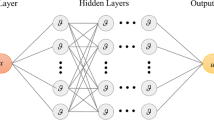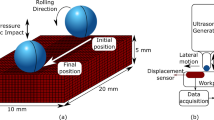Abstract
Dynamic compression experiments of GH4169 alloy at deformation temperatures of 293–873 K and strain rates of 1000–6000 s−1 were performed based on the split Hopkinson pressure bar (SHPB) experimental platform to analyze its thermal deformation behavior and constitutive models. The experimental results show that the hot deformation behavior of GH4169 alloy is mainly limited by the combined action of temperature softening and strain hardening, and the true stress decreases with the increase in the deformation temperature or the decrease in the strain rate. Based on the experimental data, an improved artificial neural network (IANN) model and the classical Johnson–Cook (J–C) constitutive model were constructed to describe the deformation behavior of the studied GH4169 alloy, and the mean absolute error (MAE) was used to evaluate the accuracy of the two models. Based on the comparison of the experimental and predicted results, at strain rates of 1000–3000 s−1, the MAE of the IANN model was 5, which was only 1/20 that of the J–C model, thereby exhibiting perfect accuracy. At strain rates of 4000–6000 s−1, the MAE of the IANN model was increased to 82 and the accuracy was decreased, but the MAE was still only 1/4 that of the J–C model. Additionally, the IANN method was embedded in a visual operation interface for the construction of constitutive models with high precision and efficiency, and could be extended to constitutive models of other alloy materials.














Similar content being viewed by others
References
Yang, X.W., Li, W.Y., Li, J., Ma, T.J., Guo, J.: FEM analysis of temperature distribution and experimental study of microstructure evolution in friction interface of GH4169 superalloy. Mater. Des. 84, 133–143 (2015)
Yang, X.W., Li, W.Y., Li, J.L., Xiao, B., Ma, T.J., Huang, Z., Guo, J.: Finite element modeling of the linear friction welding of GH4169 superalloy. Mater. Des. 87, 215–230 (2015)
Lin, Y.C., Wu, X.Y., Chen, X.M., Chen, J., Wen, D.X., Zhang, J.L., Li, L.T.: EBSD study of a hot deformed nickel-based superalloy. J. Alloy. Compd. 640, 101–113 (2015)
Wu, T., Sun, Y., Cao, Z.G.: Parameter determination of constitutive relationship of 3004H24 aluminum alloy based on ductile damage model. Structures. 34, 4447–4456 (2021)
Li, R., Miao, C.Q., Zhang, Y.L., Wang, Y.C., Chen, X.L.: Corrosion characteristics and damage constitutive model of galvanized steel wires for bridge cables. Structures. 34, 3414–3426 (2021)
Jia, X.D., Zhou, Y., Wang, Y.N.: Deformation behavior and constitutive model of 34CrNi3Mo during thermo-mechanical deformation process. Materials 15, 5220 (2020)
Wang, Y.B., Zhang, C.S., Yang, Y., Wang, Y.B., Zhao, G.Q., Chen, L.: The identification of improved Johnson-Cook constitutive model in a wide range of temperature and its application in predicting FLCs of Al–Mg–Li sheet. J. Mater. Res. Technol. 5, 3782–3795 (2020)
Ashtiani, H., Shahsavari, P.: A comparative study on the phenomenological and artificial neural network models to predict hot deformation behavior of AlCuMgPb alloy. J. Alloy. Compd. 7, 263–273 (2016)
Liu, Y., Li, M., Ren, X.W., Xiao, Z.B., Huang, Y.C.: Flow stress prediction of Hastelloy C-276 alloy using modified Zerilli-Armstrong, Johnson-Cook and Arrhenius-type constitutive models. Trans. Nonferr. Metal. Soc. 30, 3031–3042 (2020)
Liu, X.Y., Ma, H.H., Fan, F.: Modified Johnson-Cook model of SWRH82B steel under different manufacturing and cold-drawing conditions. J. Constr. Steel. Res. 186, 106894 (2021)
Zhu, S.S., Liu, J., Deng, X.: Modification of strain rate strengthening coefficient for Johnson-Cook constitutive model of Ti6Al4V alloy. Mater. Today. Commun. 26, 102016 (2021)
Zhang, H.J., Wen, W.D., Cui, H.T.: Behaviors of IC10 alloy over a wide range of strain rates and temperatures: experiments and modeling. Mater. Sci. Eng. A. 504, 99–103 (2009)
Vural, M., Caro, J.: Experimental analysis and constitutive modeling for the newly developed 2139–T8 alloy. Mater. Sci. Eng. A. 520, 56–65 (2009)
Liu, Y., Guo, B.R., Zou, X.X., Li, Y.J., Shi, S.Q.: Machine learning assisted materials design and discovery for rechargeable batteries. Energy. Storage. Mater. 31, 434–450 (2020)
Juan, Y.F., Dai, Y.B., Yang, Y., Zhang, J.: Accelerating materials discovery using machine learning. J. Mater. Sci. Technol. 79, 178–190 (2021)
Sachin, K., Pal, S.K., Pal, S.R.: A novel method based on extreme learning machine to predict heating and cooling load through design and structural attributes. Energ. Build. 176, 275–286 (2018)
Esfandiari, M.J., Urgessa, G.S.: Progressive collapse design of reinforced concrete frames using structural optimization and machine learning. Structures. 28, 1252–1264 (2020)
Geng, X.X., Mao, X.P., Wu, H.H., Wang, S.Z., Xue, W.H.: A hybrid machine learning model for predicting continuous cooling transformation diagrams in welding heat-affected zone of low alloy steels. J. Mater. Sci. Technol. 107, 207–215 (2022)
Du, J.L., Feng, Y.L., Zhang, M.H.: Construction of a machine-learning-based prediction model for mechanical properties of ultra-fine-grained Fe-C alloy. J. Mater. Res. Technol. 5, 4914–4930 (2021)
Hu, Y.Y., Xie, J., Liu, Z.X., Ding, Q.G., Zhu, W.H., Zhang, J.Y., Zhang, W.: CA method with machine learning for simulating the grain and pore growth of aluminum alloys. Comp. Mater. Sci. 142, 244–254 (2018)
Sani, S.A., Ebrahimi, G.R., Vafaeenezhad, H., Kiani-Rashid, A.R.: Modeling of hot deformation behavior and prediction of flow stress in a magnesium alloy using constitutive equation and artificial neural network (ANN) model. J. Magnes. Alloy. 6, 134–144 (2018)
Ji, G.L., Li, F.G., Li, Q.H., Zhi, L.: A comparative study on Arrhenius-type constitutive model and artificial neural network model to predict high-temperature deformation behaviour in Aermet100 steel. Mat. Sci. Eng. A. 528, 4774–4782 (2011)
Shokry, A., Gowid, S., Kharmanda, G., Mahdi, E.: Constitutive models for the prediction of the hot deformation behavior of the 10% Cr steel alloy. Materials. 12, 2873 (2019)
Saxena, A., Kumaraswamy, A., Kotkunde, N., Suresh, K.: Constitutive modeling of high-temperature flow stress of armor steel in ballistic applications: a comparative study. J. Mater. Eng. Perform. 28, 6505–6513 (2019)
Bingöl, S., Misiolek, W., Bingöl, S.: Prediction of the true stress of ZE20 magnesium alloy at different temperatures and strain rates. J. Mech. Eng. 61, 610–617 (2015)
Rezaei Ashtiani, H.R., Shayanpoor, A.A.: Hot deformation characterization of pure aluminum using artifcial neural network (ANN) and processing map considering initial grain size. Met. Mater. Int. 27, 5017–5033 (2021)
Rezaei Ashtiani, H.R., Shayanpoor, A.A.: Processing workability and artificial neural network of AA1070 to the prediction of hot flow stress. Phys. Met. Metallogr. 13, 1426–1435 (2021)
Chen, L.L., Ding, H.N., Liu, T., Luo, R., Cao, Y., Zhang, Y.X., Liu, Y., Yuan, F., Qiu, Y., Cui, S.G., Cao, Y., Cheng, X.N.: Thermal deformation behavior and microstructure evolution of GH4169 superalloy under the shear-compression deformation conditions. Mater. Des. 212, 110195 (2021)
Geng, P.H., Qin, G.L., Zhou, J., Zou, Z.D.: Hot deformation behavior and constitutive model of GH4169 superalloy for linear friction welding process. J. Manuf. Process. 32, 469–481 (2018)
Lin, Y.C., Li, K.K., Li, H.B., Chen, J., Chen, X.M., Wen, D.X.: New constitutive model for high-temperature deformation behavior of inconel 718 superalloy. Mater. Design. 74, 108–118 (2015)
Peng, S.M., Tao, W.J., Liang, Y.J., Liu, Y.J., Huan, S.: A modified method of pulse-shaper technique applied in SHPB. Compos. Part. B-Eng. 165, 215–221 (2019)
Singh, A.P., Murty, G.M.D., Jha, S.: Stress-strain behaviour of nitrogen bearing austenitic stainless steels in the temperature range 298–473 K. J. Mater Sci. 30, 6316–6328 (1995)
Saboori, M., Gholipour, J., Champliaud, H., Gakwaya, A., Savoie, J., Wanjara, P.: Effect of material model on finite element modeling of aerospace alloys. Key. Eng. Mater. 554–557, 151–156 (2013)
Lavakumar, A., Sarangi, S.S., Venkat, A.NCh., Narsimhachary, D., Ray, R.K.: A “new” empirical equation to describe the strain hardening behavior of steels and other metallic materials. Mat. Sci. Eng. A. 802, 140641 (2020)
Wang, X.M., Shi, J.: Validation of Johnson-Cook plasticity and damage model using impact experiment. Int. J. Impact. Eng. 60, 67–75 (2013)
Dinkgreve, M., Paredes, J., Denn, M.M., Bonn, D.: On different ways of measuring “the” yield stress. J. Non-Newton. Fluid. 238, 233–241 (2016)
Ding, J., Gu, Y.C., Huang, X., Song, K., Lu, S.Q., Wang, L.S.: Research on prediction accuracy of flow stress of 304 stainless steel based on artificial neural network optimized by improved genetic algorithm. J. Mech. Eng. 58, 78–86 (2022)
Sozykin, S.A.: GUI4dft-A SIESTA oriented GUI. Comput. Phys. Commun. 262, 107843 (2021)
Liu, Q., Qiao, Z., Lv, Y.: PyVT: a python-based open-source software for visualization and graphic analysis of fluid dynamics datasets. Aerosp. Sci. Tech. 117, 106961 (2021)
Fayed, M., Elhadary, M., Abderrahmane, H.A., Zakher, B.N.: The ability of forecasting flapping frequency of flexible filament by artificial neural network. Alex. Eng. J. 58, 1367–1374 (2019)
Jawad, J., Hawari, A.H., Zaidi, S.: Modeling of forward osmosis process using artificial neural networks (ANN) to predict the permeate flux. Desalination 484, 114427 (2020)
Jiang, J.F., Xiao, G.F., Wang, Y., Liu, Y.Z., Zhang, Y.: High temperature deformation behavior and microstructure evolution of wrought nickel-based superalloy GH4037 in solid and semi-solid states. Trans. Nonferr. Metal. Soc. 30, 710–726 (2020)
Qiao, J.W., Sun, A.C., Huang, E.W., Zhang, Y., Liaw, P.K., Chuang, C.P.: Tensile deformation micromechanisms for bulk metallic glass matrix composites: from work-hardening to softening. Acta. Mater. 59, 4126–4137 (2011)
Furuhara, T., Poorganji, B., Abe, H., Maki, T.: Dynamic recovery and recrystallization in titanium alloys by hot deformation. JOM-US. 59, 64–67 (2007)
Acknowledgements
This work is financially supported by the Scientific Research Foundation of Chongqing University of Technology (01192200552) and by Innovative Research Group of Chongqing Municipal Education Commission (CXQT19026), and by Chongqing Science and Technology Committee (Nos.CSTC2017JCYJAX0357), and by Foundation of National Key Defense Laboratory of Computational Physics (No.6142A0501020217).
Author information
Authors and Affiliations
Corresponding author
Ethics declarations
Conflict of interest
The authors declare that they have no conflict of interest.
Additional information
Publisher's Note
Springer Nature remains neutral with regard to jurisdictional claims in published maps and institutional affiliations.
Rights and permissions
Springer Nature or its licensor (e.g. a society or other partner) holds exclusive rights to this article under a publishing agreement with the author(s) or other rightsholder(s); author self-archiving of the accepted manuscript version of this article is solely governed by the terms of such publishing agreement and applicable law.
About this article
Cite this article
Gu, YC., Wang, LS., Huang, X. et al. Data-driven constitutive model of GH4169 alloy within a synergistic high strain rate and elevated temperature. Arch Appl Mech 93, 3341–3358 (2023). https://doi.org/10.1007/s00419-023-02442-z
Received:
Accepted:
Published:
Issue Date:
DOI: https://doi.org/10.1007/s00419-023-02442-z




